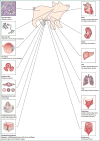Xenotransplantation: past, present, and future
- PMID: 28901971
- PMCID: PMC5935127
- DOI: 10.1097/MOT.0000000000000463
Xenotransplantation: past, present, and future
Abstract
Purpose of review: To review the progress in the field of xenotransplantation with special attention to most recent encouraging findings which will eventually bring xenotransplantation to the clinic in the near future.
Recent findings: Starting from early 2000, with the introduction of galactose-α1,3-galactose (Gal)-knockout pigs, prolonged survival especially in heart and kidney xenotransplantation was recorded. However, remaining antibody barriers to non-Gal antigens continue to be the hurdle to overcome. The production of genetically engineered pigs was difficult requiring prolonged time. However, advances in gene editing, such as zinc finger nucleases, transcription activator-like effector nucleases, and most recently clustered regularly interspaced short palindromic repeats (CRISPR) technology made the production of genetically engineered pigs easier and available to more researchers. Today, the survival of pig-to-nonhuman primate heterotopic heart, kidney, and islet xenotransplantation reached more than 900, more than 400, and more than 600 days, respectively. The availability of multiple-gene pigs (five or six genetic modifications) and/or newer costimulation blockade agents significantly contributed to this success. Now, the field is getting ready for clinical trials with an international consensus.
Summary: Clinical trials in cellular or solid organ xenotransplantation are getting closer with convincing preclinical data from many centers. The next decade will show us new achievements and additional barriers in clinical xenotransplantation.
Conflict of interest statement
The authors declare no conflict of interest.
Figures


References
Publication types
MeSH terms
Grants and funding
LinkOut - more resources
Full Text Sources
Other Literature Sources
Research Materials
Miscellaneous

